- Joined
- Feb 2, 2011
- Messages
- 2,353
NEW RELEASES FOR MARCH 2024
THE EIGHTEENTH CENTURY COLLECTION
THE AMERICAN WAR OF INDEPENDENCE 1775 – 1783
THE BATTLE OF COWPENS, JANUARY 17[SUP]th[/SUP], 1781.
The Battle of Cowpens was an engagement during the American Revolutionary War fought on January 17[SUP]th[/SUP] 1781, near the town of Cowpens, South Carolina, between American forces under Brigadier General Daniel Morgan, and British forces under Lieutenant Colonel Banastre Tarleton, as part of the campaign in the Carolinas.
The battle was a turning point in the American reconquest of South Carolina from the British.
Tarleton’s force of 1,000 British troops were set against 2,000 troops under Morgan. Morgan’s forces suffered casualties of only 25 killed and 124 wounded. Tarleton’s force was almost completely eliminated with almost 30% casualties and 55% of his force captured or missing, with Tarleton himself and only about 200 British troops escaping.
Morgan’s forces conducted a double envelopment of the British forces, the only double envelopment of the war.
AMERICAN CONTINENTAL AND MILITIA DRAGOONS
One of Brigadier General Daniel Morgan’s greatest concerns was his lack of adequate numbers of dragoons. Dragoons served both sides as scouts, mounted pickets, mobile reserves, and shock troops. One of their primary functions was to exploit a victory by riding down the remnants of broken enemy infantry. Weapons included a carbine and a brace of heavy pistols, Although according to Colonel William Washington the “only necessary weapon a dragoon carries” was the sabre.
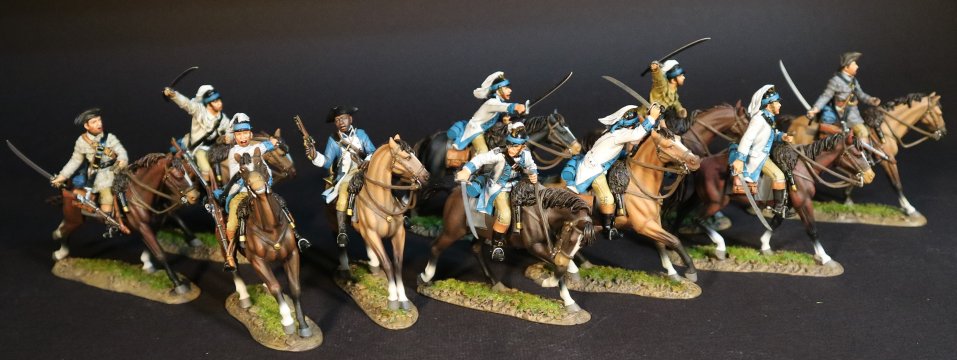
Several small volunteer militia contingents were hastily equipped as dragoons to reinforce the cavalry, as it was well known the strength of Tarleton’s mounted legion.
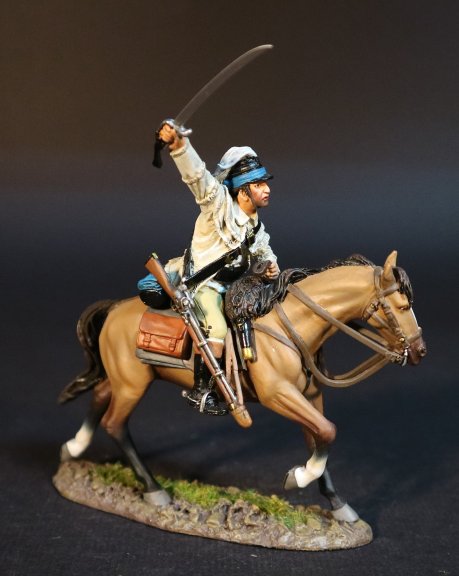
CW3LD-07A
THE AMERICAN WAR OF INDEPENDENCE 1775 – 1783
THE BATTLE OF COWPENS, JANUARY 17[SUP]th[/SUP], 1781.
AMERICAN CONTINENTAL AND MILITIA DRAGOONS,
CONTINENTAL DRAGOON.
(2 pcs)
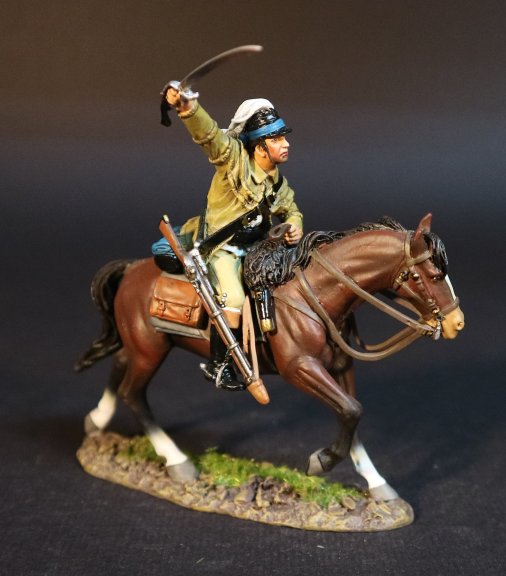
CW3LD-07B
THE AMERICAN WAR OF INDEPENDENCE 1775 – 1783
THE BATTLE OF COWPENS, JANUARY 17[SUP]th[/SUP], 1781.
AMERICAN CONTINENTAL AND MILITIA DRAGOONS,
CONTINENTAL DRAGOON.
(2 pcs)
THE BRITISH LEGION
The British Legion was a British provincial regiment established during the American Revolutionary War, composed of British loyalist American infantry and dragoons. It was known as Tarleton’s Raiders after the British officer who led most of its day to day activities, Lieutenant Colonel Banastre Tarleton, and the green uniform coats. It was an unit the size of a regiment consisting of infantry, cavalry, and artillery, and able to operate independently.

The unit was raised in New York in July 1778 by Sir Henry Clinton in order to merge combined infantry and cavalry forces and a battery of light artillery.
The regiment was commanded by William Lord Cathcart, as colonel.
Once the unit left New York, Banastre Tarleton was commissioned as Lieutenant colonel, and took full operational command.
The Legion’s peak operational strength was approximately 250 cavalry and 200 infantry.
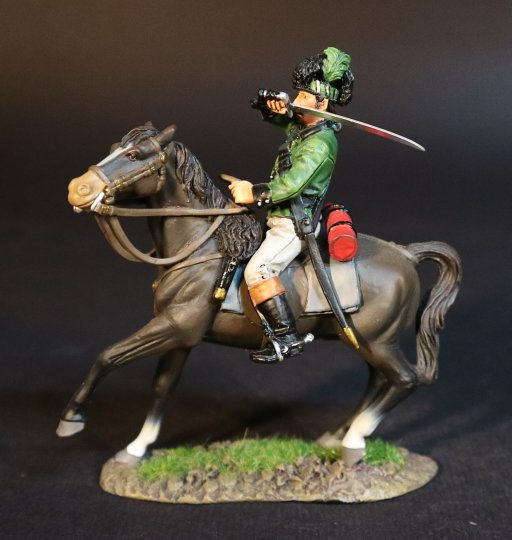
CWBL-07
THE AMERICAN WAR OF INDEPENDENCE 1775 – 1783
THE BATTLE OF COWPENS, JANUARY 17[SUP]th[/SUP], 1781.
THE BRITISH LEGION – “TARLETON’S RAIDERS”,
TROOPER.
(2 pcs)
THE 17[SUP]th[/SUP] LIGHT DRAGOONS
Formed in 1759, the regiment was sent to Boston in 1775 to help quell the growing rebellion. Only a small part of the regiment was sent south and was attached to Tarleton’s command. They are said to have clung to the by now bedraggled scarlet coats that set them apart from the green uniformed Provincials of the British Legion.
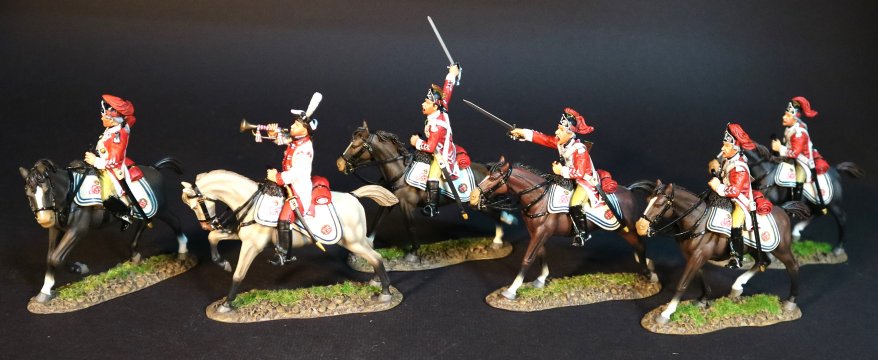
Only about a hundred dragoons were present at the Cowpens battle, and it was the only unit to retire from the battlefield in good order.
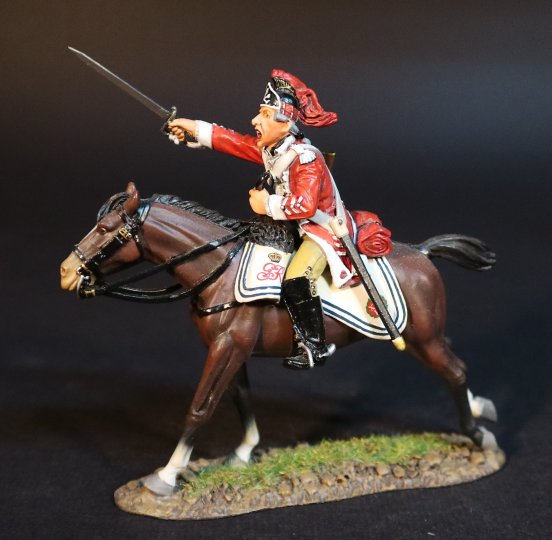
CW17-03
THE AMERICAN WAR OF INDEPENDENCE 1775 – 1783
THE BATTLE OF COWPENS, JANUARY 17[SUP]th[/SUP], 1781.
THE BRITISH ARMY,
THE 17[SUP]th[/SUP] LIGHT DRAGOONS.
TROOPER.
(2 pcs)
THE QUEEN’S RANGERS (1[SUP]st[/SUP] AMERICAN REGIMENT) 1778-1783
SIMCOE’S RANGERS
The Queen’s Rangers came into being when Robert Rogers was authorized to raise a “Corps of Provincials” on August 16[SUP]th[/SUP] 1776. Recruited originally from Loyalists in New York and Connecticut, its men were farmers and city dwellers with little military experience.
They were a Loyalist military unit and were named for Queen Charlotte, consort of George III. The Queen’s Rangers served as a light corps in the tradition of British Rangers during the war, operating on the flanks and in advance of Crown forces, manning outposts, conducting patrols, and carrying out reconnaissance and raiding operations.
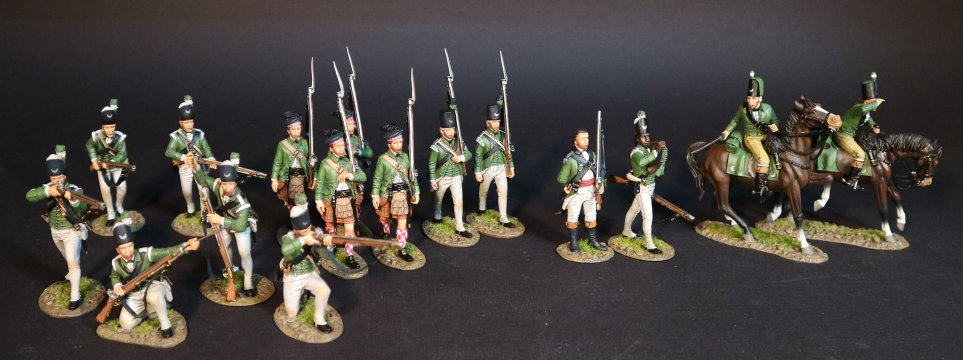
Following an inauspicious start when it was mauled by an American surprise attack at Mamaroneck in October 1776, it participated successfully in various campaigns throughout the Revolution until the surrender at Yorktown.
In a period of about a year, the Rangers had three commanding officers following Rogers. Major Christopher French reorganized the corps, during which process many officers and enlisted men were discharged. He was followed by Major James Wemyss in May 1777, under whom the unit increased in size and efficiency, participating in the Brunswick raid of June 1777. In the Battle of Brandywine, the command suffered the loss of one third of its number in killed or wounded, fourteen of twenty one commissioned officers were casualties.
Wemyss was wounded at the battle of Germantown. Major John Graves Simcoe succeeded him as commanding officer on October 15[SUP]th[/SUP], 1777.
It was under Simcoe that the Rangers reached the height of its efficiency. Starting as an infantry command, it gradually expanded and before its surrender at Yorktown consisted of eleven companies of foot, including riflemen, light infantry, grenadiers and a highland company, as well as dragoons, Hussars and some light guns.
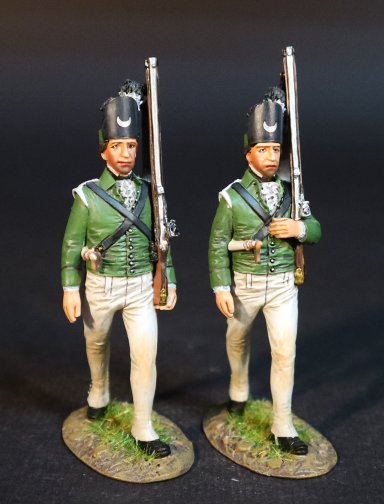
SQR-10
THE AMERICAN WAR OF INDEPENDENCE 1775 – 1783
THE BRITISH ARMY,
THE QUEEN’S RANGERS 1778-1783,
SIMCOE’S RANGERS,
2 RIFLEMEN
Simcoe had advanced ideas regarding training and discipline. He advocated constant vigilance, physical activity, and endurance of fatigue. There was constant instruction in marksmanship, the use of the bayonet, open formations, and the use of ambuscades. Units were trained to seldom return by their outgoing route. Officers were selected on their ability to perform such duties, and promotions when they occurred were from within the corps.
Regularity of messing and cleanliness were stressed, and officers were held responsible for the health of their men.
Written orders were avoided when possible, officers met after parade and received their orders verbally.
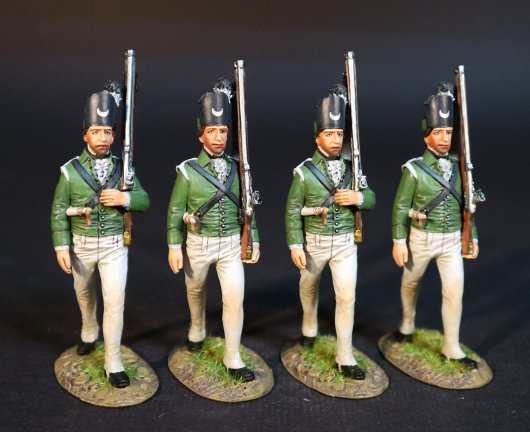
SQR-10N
THE AMERICAN WAR OF INDEPENDENCE 1775 – 1783
THE BRITISH ARMY,
THE QUEEN’S RANGERS 1778-1783,
SIMCOE’S RANGERS,
4 RIFLEMEN
After the war, the Rangers were removed to the British colony of Nova Scotia and disbanded.
** PLEASE CONTACT YOUR LOCAL DEALER FOR FURTHER INFORMATION **
THE EIGHTEENTH CENTURY COLLECTION
THE AMERICAN WAR OF INDEPENDENCE 1775 – 1783
THE BATTLE OF COWPENS, JANUARY 17[SUP]th[/SUP], 1781.
The Battle of Cowpens was an engagement during the American Revolutionary War fought on January 17[SUP]th[/SUP] 1781, near the town of Cowpens, South Carolina, between American forces under Brigadier General Daniel Morgan, and British forces under Lieutenant Colonel Banastre Tarleton, as part of the campaign in the Carolinas.
The battle was a turning point in the American reconquest of South Carolina from the British.
Tarleton’s force of 1,000 British troops were set against 2,000 troops under Morgan. Morgan’s forces suffered casualties of only 25 killed and 124 wounded. Tarleton’s force was almost completely eliminated with almost 30% casualties and 55% of his force captured or missing, with Tarleton himself and only about 200 British troops escaping.
Morgan’s forces conducted a double envelopment of the British forces, the only double envelopment of the war.
AMERICAN CONTINENTAL AND MILITIA DRAGOONS
One of Brigadier General Daniel Morgan’s greatest concerns was his lack of adequate numbers of dragoons. Dragoons served both sides as scouts, mounted pickets, mobile reserves, and shock troops. One of their primary functions was to exploit a victory by riding down the remnants of broken enemy infantry. Weapons included a carbine and a brace of heavy pistols, Although according to Colonel William Washington the “only necessary weapon a dragoon carries” was the sabre.

Several small volunteer militia contingents were hastily equipped as dragoons to reinforce the cavalry, as it was well known the strength of Tarleton’s mounted legion.

CW3LD-07A
THE AMERICAN WAR OF INDEPENDENCE 1775 – 1783
THE BATTLE OF COWPENS, JANUARY 17[SUP]th[/SUP], 1781.
AMERICAN CONTINENTAL AND MILITIA DRAGOONS,
CONTINENTAL DRAGOON.
(2 pcs)

CW3LD-07B
THE AMERICAN WAR OF INDEPENDENCE 1775 – 1783
THE BATTLE OF COWPENS, JANUARY 17[SUP]th[/SUP], 1781.
AMERICAN CONTINENTAL AND MILITIA DRAGOONS,
CONTINENTAL DRAGOON.
(2 pcs)
THE BRITISH LEGION
The British Legion was a British provincial regiment established during the American Revolutionary War, composed of British loyalist American infantry and dragoons. It was known as Tarleton’s Raiders after the British officer who led most of its day to day activities, Lieutenant Colonel Banastre Tarleton, and the green uniform coats. It was an unit the size of a regiment consisting of infantry, cavalry, and artillery, and able to operate independently.

The unit was raised in New York in July 1778 by Sir Henry Clinton in order to merge combined infantry and cavalry forces and a battery of light artillery.
The regiment was commanded by William Lord Cathcart, as colonel.
Once the unit left New York, Banastre Tarleton was commissioned as Lieutenant colonel, and took full operational command.
The Legion’s peak operational strength was approximately 250 cavalry and 200 infantry.

CWBL-07
THE AMERICAN WAR OF INDEPENDENCE 1775 – 1783
THE BATTLE OF COWPENS, JANUARY 17[SUP]th[/SUP], 1781.
THE BRITISH LEGION – “TARLETON’S RAIDERS”,
TROOPER.
(2 pcs)
THE 17[SUP]th[/SUP] LIGHT DRAGOONS
Formed in 1759, the regiment was sent to Boston in 1775 to help quell the growing rebellion. Only a small part of the regiment was sent south and was attached to Tarleton’s command. They are said to have clung to the by now bedraggled scarlet coats that set them apart from the green uniformed Provincials of the British Legion.

Only about a hundred dragoons were present at the Cowpens battle, and it was the only unit to retire from the battlefield in good order.

CW17-03
THE AMERICAN WAR OF INDEPENDENCE 1775 – 1783
THE BATTLE OF COWPENS, JANUARY 17[SUP]th[/SUP], 1781.
THE BRITISH ARMY,
THE 17[SUP]th[/SUP] LIGHT DRAGOONS.
TROOPER.
(2 pcs)
THE QUEEN’S RANGERS (1[SUP]st[/SUP] AMERICAN REGIMENT) 1778-1783
SIMCOE’S RANGERS
The Queen’s Rangers came into being when Robert Rogers was authorized to raise a “Corps of Provincials” on August 16[SUP]th[/SUP] 1776. Recruited originally from Loyalists in New York and Connecticut, its men were farmers and city dwellers with little military experience.
They were a Loyalist military unit and were named for Queen Charlotte, consort of George III. The Queen’s Rangers served as a light corps in the tradition of British Rangers during the war, operating on the flanks and in advance of Crown forces, manning outposts, conducting patrols, and carrying out reconnaissance and raiding operations.

Following an inauspicious start when it was mauled by an American surprise attack at Mamaroneck in October 1776, it participated successfully in various campaigns throughout the Revolution until the surrender at Yorktown.
In a period of about a year, the Rangers had three commanding officers following Rogers. Major Christopher French reorganized the corps, during which process many officers and enlisted men were discharged. He was followed by Major James Wemyss in May 1777, under whom the unit increased in size and efficiency, participating in the Brunswick raid of June 1777. In the Battle of Brandywine, the command suffered the loss of one third of its number in killed or wounded, fourteen of twenty one commissioned officers were casualties.
Wemyss was wounded at the battle of Germantown. Major John Graves Simcoe succeeded him as commanding officer on October 15[SUP]th[/SUP], 1777.
It was under Simcoe that the Rangers reached the height of its efficiency. Starting as an infantry command, it gradually expanded and before its surrender at Yorktown consisted of eleven companies of foot, including riflemen, light infantry, grenadiers and a highland company, as well as dragoons, Hussars and some light guns.

SQR-10
THE AMERICAN WAR OF INDEPENDENCE 1775 – 1783
THE BRITISH ARMY,
THE QUEEN’S RANGERS 1778-1783,
SIMCOE’S RANGERS,
2 RIFLEMEN
Simcoe had advanced ideas regarding training and discipline. He advocated constant vigilance, physical activity, and endurance of fatigue. There was constant instruction in marksmanship, the use of the bayonet, open formations, and the use of ambuscades. Units were trained to seldom return by their outgoing route. Officers were selected on their ability to perform such duties, and promotions when they occurred were from within the corps.
Regularity of messing and cleanliness were stressed, and officers were held responsible for the health of their men.
Written orders were avoided when possible, officers met after parade and received their orders verbally.

SQR-10N
THE AMERICAN WAR OF INDEPENDENCE 1775 – 1783
THE BRITISH ARMY,
THE QUEEN’S RANGERS 1778-1783,
SIMCOE’S RANGERS,
4 RIFLEMEN
After the war, the Rangers were removed to the British colony of Nova Scotia and disbanded.
** PLEASE CONTACT YOUR LOCAL DEALER FOR FURTHER INFORMATION **

